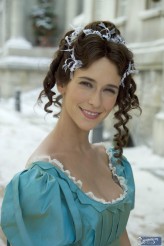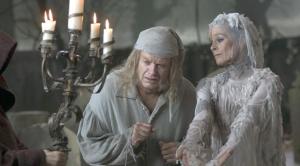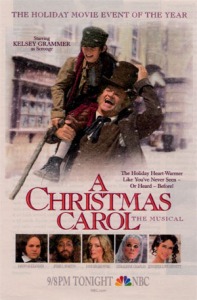We have now come to A Christmas Carol: The Musical from 2004.
The title alone was always a red flag for me; in it is a slight insinuation that this musical adaptation is a unique undertaking. Of course, most know this isn’t true by the common familiarity of the 1970 theatrical film musical. But A Christmas Carol has a musical tradition as far back as its original print publication. There was a musical version playing in New York within the first year of the novella’s release. The form of musicals as we know them today are a 20th century development, so the earlier musical versions would have been fairly different but they were there. An adaptation of A Christmas Carol in the more familiar form of modern musicals didn’t happen until the 1950’s. 1956’s The Stingiest Man in Town is the first true modern style musical working of A Christmas Carol (though some may argue 1954’s television version as the first). Since then, it’s been done musically very often on stage, animated versions, and theatrical film. A Christmas Carol: The Musical is really just one of the more recent treatments in the last two decades.
Unlike other modern musical adaptations, this one started as an actual stage musical. It was a seasonal theatrical offering in New York City every year for nine years starting in 1994. Being the huge theatre geek and A Christmas Carol fanatic that I am, I’m even surprised at myself for never having seen the stage version during its time.
I’m unsure whether to consider the Ebenezer Scrooge role as an actual star vehicle, but the role usually attracted a major talent (usually Hollywood) every year.
Let’s get it out of the way now. This isn’t so great. What I personally find frustrating with this ACC is that I want to like it but never do when seeing it. This is predominantly because of the story’s adaptation of Dickens’ masterpiece. Most versions take some type of liberties or add something unique, but this happens too often in this envisioning. I can actually envision how the book to this musical would work on stage; it doesn’t translate at all to screen (big or small). The saving grace for this attempt is the Alan Menken song score (Lynn Ahren lyrics).
The movie opens with a production number (it is a musical after all) and a non-traditional scene with Scrooge and Bob Cratchit at the Exchange instead of the counting house. Some of the early famous lines are delivered here. We are introduced to a man named Smythe, in debt to Scrooge, and his daughter whose purpose is to tug at the audience’s heart strings and sets the pace for the overdone representations of the family unit and children (because Tiny Tim and the other Cratchit children do not seem to be adequate enough for the creators in this version). This movie too blatantly, gratuitously, and unnecessarily emphasizes the nuclear family by adding it in all over the story instead of letting the Cratchits suffice as they should. The attempt to even out the genders to also too forced.
There is a long, continuous musical number of expositions as Scrooge, played by Kelsey Grammer, walks through the streets of London. This is where Scrooge encounters the charity solicitors appearing as a singing trio (their part is very good!). Staying in the streets, this is also where Scrooge has an exchange with his nephew, Fred. When Fed runs into his uncle in the streets, he does his dinner invitation as part of the musical number.
My opinion is that this is not too original. The 1970 film musical also has singing street scenes near the very beginning that include Scrooge, Bob Cratchit and miscellaneous characters they run into. Also during this number, Scrooge encounters three different characters: a female lamplighter, a charity theatre performer, and a blind, old woman beggar. These become the three individual ghosts that visit Scrooge. The charity performer sings “life will pass you by in just a while, Sir” as a precursory line as the Ghost of Christmas Present. After Scrooge refuses to help the Lamplighter, she sings to him, “you’ll be sorry, Sir, when you look back!” which is a foreshadowing of her being the Ghost of Christmas Past. Ignoring the blind beggar she sings to him “…come the future you’ll remember me” hinting her later appearance as the Ghost of Christmas Yet to Come.
Scrooge finally ends up in front of his house. Marley’s voice calls to Scrooge a couple of times before his face appears on the doorknocker. Jason Alexander as Marley’s Ghost appears through the wall instead of the door. It’s a bit much for me when Marley immediately becomes sentimental seeing Scrooge and tries to embrace him. Alexander is a good musical performer and his number as Marley, “Link by Link” is a good song but he’s miscast as Marley. The wandering spirits appear in Scrooge’s room and are part of the song; they are also used as a good excuse to get some special effects in. This is at least one of three different versions where the Wandering Spirits are part of a musical number with Jacob Marley (and I’ll never get used to it). During the song, we meet an old friend of Scrooge as one of the spirits. This was actually done first in 1956’s The Stingiest Man in Town.
The Ghost of Christmas Past, formally the female lamplighter, appears and presents Scrooge with a book of his life. Scrooge opens book and sees a live action version of himself as a boy. The scenes from the past are Scrooge and the Ghost going through the book. She sings the song “The Lights of Long Ago” to complement her earlier role as a lamplighter. Then it gets pretty strange.
 There is a past scene with Scrooge’s father going to debtor’s prison. Of course we see young sister, Fan, but along with the innovation of his father, Scrooge’s mother is there, too! This now bundles Scrooge into the sentimental package of the visible family unit. Scrooge’s mother sings a solo song. Scrooge’s mother is the first to say (sing) the line “God bless us, everyone.“ The Ghost says to Scrooge, “Your mother died soon afterwards” this time borrowing from the 1951 film. Then there is a scene that is probably inspired from Dickens’ own life as Young Scrooge is shown working in a boot factory. He declares he intends to make his fortune and keep it. Through this, Scrooge and Fan correspond by letter. There is no school. Back in Scrooge’s room, he and the ghost are again seen reading the book. It is mentioned about Fan dying during childbirth – another borrowing from other adaptations. Then it’s Fezziwig’s ball. In this version, Jacob Marley is also an employee at Fezziwig’s. Scrooge’s love is renamed Emily instead of Belle. Emily is played by Jennifer Love Hewitt.
There is a past scene with Scrooge’s father going to debtor’s prison. Of course we see young sister, Fan, but along with the innovation of his father, Scrooge’s mother is there, too! This now bundles Scrooge into the sentimental package of the visible family unit. Scrooge’s mother sings a solo song. Scrooge’s mother is the first to say (sing) the line “God bless us, everyone.“ The Ghost says to Scrooge, “Your mother died soon afterwards” this time borrowing from the 1951 film. Then there is a scene that is probably inspired from Dickens’ own life as Young Scrooge is shown working in a boot factory. He declares he intends to make his fortune and keep it. Through this, Scrooge and Fan correspond by letter. There is no school. Back in Scrooge’s room, he and the ghost are again seen reading the book. It is mentioned about Fan dying during childbirth – another borrowing from other adaptations. Then it’s Fezziwig’s ball. In this version, Jacob Marley is also an employee at Fezziwig’s. Scrooge’s love is renamed Emily instead of Belle. Emily is played by Jennifer Love Hewitt.
There is a large production number during the Fezziwig ball. This would be expected as that scene lends itself out to a large number. Scrooge proposes to Emily at the ball. Shown is a young Scrooge & Marley running their business. We then see a more aged Scrooge & Marley running their business as they become hard. The Fezziwig’s appear for a loan, which Scrooge & Marley will not give to help save Fezziwig’s business. This idea was also done in 1979’s American Christmas Carol. We also see Marley’s death in the flashback.
At the end of the Past sequence, the ghost appears in a candle flame and Scrooge uses a regular candlesnuffer to put it out and make her disappear.
A traditional Ghost of Christmas Present is done. The Ghost then performs on a stage for his musical number.
The gender equality comes into play again. The little Smythe girl from the beginning is emphasized in the theatre. Much of this version takes away from Tiny Tim so the sentimental empathy can be on the little girl. Then it’s to the Cratchit house. Then it’s back to the streets of London. Finally there is a trip to nephew Fred’s. With the family unit being the most important sugary subtext going on, Fred and his wife have a son. However, the added scene where Bob Cratchit carries Tiny Tim to bed and cares for him is a good and genuinely moving scene with a decent song by Scrooge as it plays out.
 The Ghost of Christmas Yet to Come is a truly radical shift for any version of A Christmas Carol. The traditional dark, hooded robe is gone in place of a woman with a light colored costume. The woman is actually the blind beggar woman from the beginning. She switches senses, from being blind and speaking as the beggar, to seeing but being mute as the ghost. The entire Cratchit family is seen at Tiny Tim’s gravesite. That little Smythe girl pops in again during the future and sings a song followed by a gaggle of other children and finally Scrooge’s mother with Fan! Now it’s the little girl that gets the “God bless us, everyone” line in a song and is eventually joined by everyone in the scene. The end of scene with the Ghost reminds me of Fruma Sarah from the “Ttevye’s Dream” musical number from Fiddler on the Roof.
The Ghost of Christmas Yet to Come is a truly radical shift for any version of A Christmas Carol. The traditional dark, hooded robe is gone in place of a woman with a light colored costume. The woman is actually the blind beggar woman from the beginning. She switches senses, from being blind and speaking as the beggar, to seeing but being mute as the ghost. The entire Cratchit family is seen at Tiny Tim’s gravesite. That little Smythe girl pops in again during the future and sings a song followed by a gaggle of other children and finally Scrooge’s mother with Fan! Now it’s the little girl that gets the “God bless us, everyone” line in a song and is eventually joined by everyone in the scene. The end of scene with the Ghost reminds me of Fruma Sarah from the “Ttevye’s Dream” musical number from Fiddler on the Roof.
By the time the Ghosts are done with Scrooge, the movie allows only under eight minutes to give us the reformed Scrooge and his Christmas Day actions.
This makes for an interesting and sometimes entertaining screening but I think it is best left to the stage.

I was lucky enough to see this on stage with Frank Langella (!) who was pretty fantastic. VERY disappointed in the TV version. It sucked all the life from the show (sort of like The Wiz film did).
The score in the stage version is one my favorites from recent decades.
LikeLike